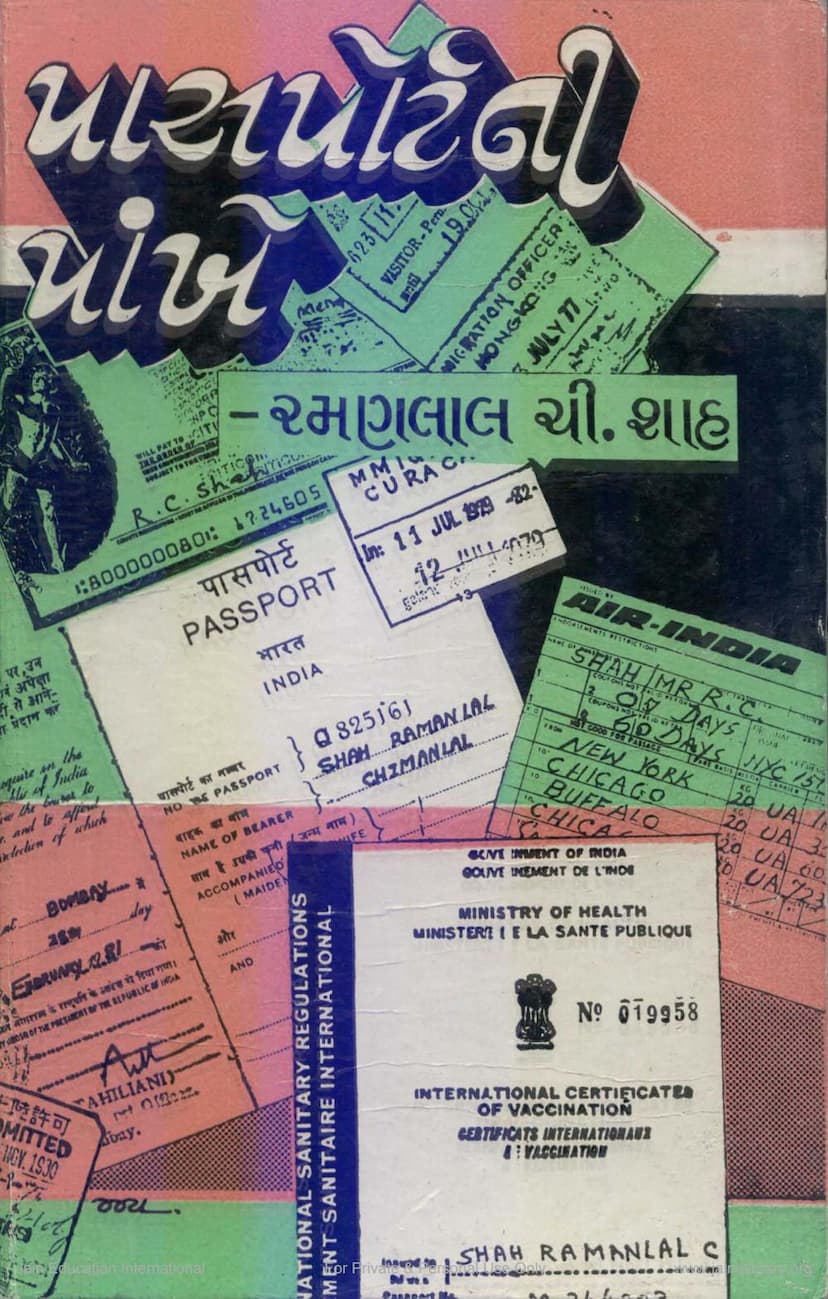Passportni Pankhe Part 1
Added to library: September 2, 2025

Summary
Here's a comprehensive summary of "Passportni Pankhe Part 1" by Ramanlal C. Shah, based on the provided pages:
Book Title: Passportni Pankhe Part 1 (On the Wings of a Passport)
Author: Dr. Ramanlal C. Shah
Publisher: Shree Mumbai Jain Yuvak Sangh
Overview:
"Passportni Pankhe Part 1" is a collection of travel experiences and observations by the renowned Gujarati author Dr. Ramanlal C. Shah. The book compiles a series of his foreign travelogues, offering readers a glimpse into his journeys across various countries. Dr. Shah's writing is characterized by its engaging narrative style, insightful observations of different cultures, people, and customs, and a subtle undercurrent of reflection and wisdom. The book is a testament to his extensive travels and his ability to connect with diverse experiences through his unique perspective.
Key Themes and Content:
The book, as indicated by the title and the initial pages, centers around Dr. Shah's international travels. The initial pages (1-2) of the provided text show scanned images of a passport and an international certificate of vaccination, highlighting the official documentation associated with foreign travel. Page 2 explicitly states the author, publisher, and principal seller, confirming the book's focus on travel.
The author's preface (pages 8-11) reveals the genesis of these travel writings. Dr. Shah began writing about his foreign travels after receiving an invitation to Japan in 1968, which marked his first opportunity to travel abroad. Over the subsequent decade and a half, he had the chance to visit numerous countries for various reasons: delivering lectures on Jainism and Buddhism, participating in international PEN congresses, witnessing the Olympics, and meeting friends and relatives. He emphasizes that travel provides a natural opportunity to observe and reflect on the differences in people's lifestyles, customs, languages, and mindsets compared to his own.
The author acknowledges that he was often encouraged by friends and relatives to write down these experiences, but he had been delaying it. He mentions an influential recommendation from Shri Umashankar Joshi to not delay writing travel memoirs and to meticulously record details in a diary during travels, as memory can fade over time.
Dr. Shah credits the editor of "Samarpan" and later "Navnit-Samarpan," Shri Ghanshyam Desai, for his encouragement and consistent publication of these travelogues, which motivated him to write more. He expresses gratitude to various esteemed literary figures and well-wishers who responded positively to his writings. He also specifically mentions the valuable contributions and suggestions of the late Shri Bhriguray Anjaria, who meticulously reviewed the manuscripts and offered corrections, particularly regarding the spelling of English names.
Thematic Elements Drawn from Chapter Titles:
While the provided text doesn't contain the full content of each chapter, the chapter titles themselves offer a strong indication of the book's diverse content:
- Cultural Observations and Interactions: Chapters like "Shikago Jata" (Going to Chicago), "Veitar nu Vatsalya" (The Waiter's Affection), "Nepali Divi" (The Nepali Lamp), and "Seth Pauli" likely delve into Dr. Shah's encounters with local people and their way of life. The "Veitar nu Vatsalya" chapter, for instance, seems to highlight an act of kindness from a waiter. The "Nepali Divi" chapter might explore interactions with Nepalese culture or individuals during his travels.
- Societal Norms and Customs: "Ghatamundan" (Sheep Shearing) suggests an exploration of agricultural practices or rural life, potentially in a country like New Zealand, known for its sheep farming. "Kutumbaprem" (Family Love) might contrast family structures in different cultures. "Viparyay" (Contradiction/Paradox) hints at observations that challenge preconceived notions or reveal surprising aspects of a place.
- Unique Experiences and Observations: Chapters like "Gatā Phala" (Singing Fruit) and "Shugandha ane Durgandha" (Fragrance and Foul Smell) promise unusual and sensory experiences, possibly related to local produce or environmental observations. "Batu Gufao" (Batu Caves) suggests a visit to a natural attraction, likely in Malaysia given its mention. "Pattam-ham no Dhodh" (Pattam-ham Waterfall) similarly points to exploring a natural wonder, possibly in the Philippines. "V.I.P. Room" and "Kimati Nastō" (Valuable Breakfast) hint at luxury or unexpected hospitality. "Mādhraat nu Mūzhavan" (Midnight Dilemma) suggests a challenging or puzzling situation.
- Historical and Cultural Insights: "Pannamunjom" (Panmunjom) and "Timki Timki ne Joranara" (Those Who Stare Intently) likely offer insights into geopolitical situations or unique cultural observations. The Panmunjom chapter, in particular, allures to the heavily guarded border between North and South Korea, hinting at political and historical context. "Timki Timki ne Joranara" might refer to people's behavior or particular customs observed.
- Everyday Life and Practicalities: Chapters like "Bhākhri no Swād" (The Taste of Bhākhri) and "Riono Ratre" (In Rio at Night) could offer details about food and evening experiences. "Savo Pārk" (Savo Park) suggests wildlife encounters. "Nāirobīmā Gundagīri" (Goondaism in Nairobi) points to observations about safety and social issues in a particular city.
- Linguistic and Communication Challenges: "Uchcharan ni Khasiyat" (Peculiarities of Pronunciation) and "French Visani Samasyā" (The French Visa Problem) highlight the author's experiences with language barriers and bureaucratic hurdles.
- Social Commentary and Reflection: The variety of titles suggests Dr. Shah's knack for weaving in social commentary, perhaps on economic disparities ("Loe Loko" - The Loe People), cultural differences, or personal reflections ("Vishad ane Ullās" - Sadness and Joy).
Author's Approach:
Dr. Shah's approach to travel writing seems to be rooted in keen observation, a desire to understand different cultures, and a genuine appreciation for human interactions, even in the face of language barriers or challenging circumstances. His willingness to record personal experiences, both positive and negative, makes the book relatable and authentic. The initial pages also showcase the publisher's dedication to making his works accessible, as indicated by the multiple editions and the release of copyrighted material without restriction.
Overall Impression:
"Passportni Pankhe Part 1" appears to be a rich tapestry of international experiences, offering readers not just a description of places but also a deeper understanding of the human element encountered during travel. The book is likely to be both informative and entertaining, reflecting the author's broad intellectual curiosity and his engaging storytelling abilities.